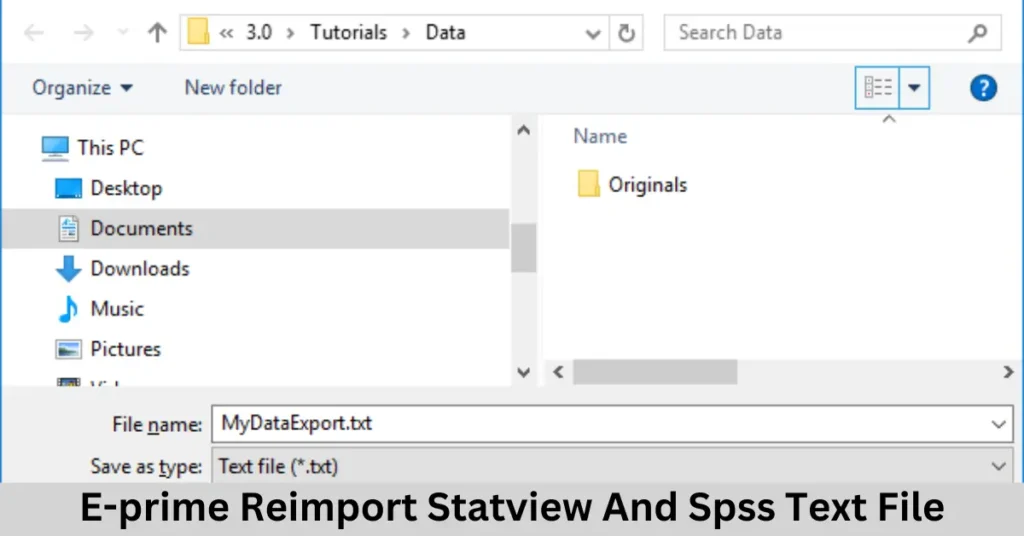Introduction
E-prime Reimport Statview and Spss Text File, Data analysis is very important nowadays in research. Researchers and analysts rely on effective analysis of data. Working with E-prime, a software that is popularly used in designing and running psychological experiments, understanding how data can be reimported to a program like StatView or SPSS is a major contribution to the data analysis process.
This guide will take you through both export and reimport processes so that you can fully utilize your findings and gain even deeper insight. So, whether you’re a wizened professional analyst or a fledgling beginner, these techniques will ensure that you become equipped for super-research.
What Is E-prime Reimport Statview And Spss Text File?
They have got power for designing as well as conducting psychological experiments and generating scales for the measurement of behavior using different experimental conditions by E-prime. However, in order to obtain meaningful information from it, imported data needs to be converted back into statistical analysis programs like StatView and SPSS.
Basically, reimporting these things allows the user to organize the experiment results, analyze, and even visualize them. Since E-Prime has been converted into formats compatible with these software tools, the analyst/experimenter would then have an opportunity to have much deeper insights and improve the findings.
Why is E-Prime Reimport Statview And Spss Text File Important?
Reimport of E-Prime data is required for the several reasons such as:
- Data Analysis Advancement: Both of these packages provide advanced statistical consideration for in-depth understanding and more accurate conclusions on experimental findings.
- Data Structuring Improvement: Data is effectively structured to help navigate and analyze the information easily.
- Error Reduction: Proper reimport of data avoids manual data entry and conversion errors.
- Integrated Work: Wielding E-Prime with StatView and SPSS for analysis creates a seamless workflow that saves time and increases researchers’ efficiency.
- Robust Reporting: It further enables comprehensive research reports and visualizations coming out of these statistical tools.
Reimport Statview And Spss Text File Data Export Process
Exporting is a very important aspect when it comes to making use of your experiment findings. Here is how you can go about this very important step:
- Open Your E-Prime Project: Open the E-prime experiment you want to export data.
- Find the Data File: This is the link which generally contains your data titled ‘data’ or ‘Results’.
- Select Export Options: Click the export option and select the preferred file type from the long list displayed. For instance, you can select text file format.
- Save The File: Now, you can name this file and choose its location on your PC for storing.
- Confirm Export: Confirm that the export will show if there is a successful file creation.
Then you can share your data easily with everyone or use it within stat viewpoint.iew and SPSS for analysis!
Also Read: PDAs
Reimporting Data into StatView
Reimporting your data iThrough StatView, one can have everything required for making a successful experiment; in fact with E-prime, it becomes much easier. It’s very friendly and simple to start with.
Here is how to open StatView: Start the StatView program on your PC, and there will appear a neat and clean workspace for you to begin analysis.
Look for Import: You will look for an option saying “Import” or “Open Data.” This is usually found at the top of your screen in the main menu. Click it, and you can start introducing your E-Prime data into StatView.
Locate Your E-Prime File: Then, a window opens so that you can find the file you saved from E-Prime. Remember, it should be in the format exported earlier, such as text file. Go to the folder that contains the saved data, and select the file.
Choose The Right Settings: After you have selected a file, StatView may ask you how you want to import your data. This is really crucial. Be very sure that you will use the right settings, as it will import your data correctly. Among options, you may find how to separate them with commas or tabs. But if you are not sure, the default settings will usually be right.
Importing Data: When all that is done, go ahead and click that button which states ‘Import’ or ‘OK’. StatView goes through importing your data; this process would take just a few seconds depending on how huge your data is.
Check Data: After that, check your data for correctness in StatView. Look to see whether everything is ok, and the results from the E-Prime have completely transferred over. If not well imported, you can go back and redo it.
Start the Analysis: Now start analyzing your data with StatView! That is where you can make use of the various tools of StatView for creating charts, graphs, and tables. You are likely to get some new findings from your experiment here!but with a little practice, you’ll be able to do it easily.
Reimporting Data into SPSS
Through StatView, one can have everything required for making a successful experiment; in fact with E-prime, it becomes much easier. It’s very friendly and simple to start with.
- Here is how to open StatView: Start the StatView program on your PC, and there will appear a neat and clean workspace for you to begin analysis.
- Look for Import: You will look for an option saying “Import” or “Open Data.” This is usually found at the top of your screen in the main menu. Click it, and you can start introducing your E-Prime data into StatView.
- Locate Your E-Prime File: Then, a window opens so that you can find the file you saved from E-Prime. Remember, it should be in the format exported earlier, such as text file. Go to the folder that contains the saved data, and select the file.
- Choose The Right Settings: After you have selected a file, StatView may ask you how you want to import your data. This is really crucial. Be very sure that you will use the right settings, as it will import your data correctly. Among options, you may find how to separate them with commas or tabs. But if you are not sure, the default settings will usually be right.
- Importing Data: When all that is done, go ahead and click that button which states ‘Import’ or ‘OK’. StatView goes through importing your data; this process would take just a few seconds depending on how huge your data is.
- Check Data: After that, check your data for correctness in StatView. Look to see whether everything is ok, and the results from the E-Prime have completely transferred over. If not well imported, you can go back and redo it.
- Start the Analysis: Now start analyzing your data with StatView! That is where you can make use of the various tools of StatView for creating charts, graphs, and tables. You are likely to get some new findings from your experiment here!using at first, but with practice, you’ll get the hang of it! Soon enough, you’ll be analyzing your E-Prime data like a professional!
Advantages and Disadvantages of E-Prime Reimport to StatView and SPSS
Advantages of E-Prime Reimport to StatView and SPSS
| Advantages |
| Enhanced Analysis: Both StatView and SPSS have powerful engine’s that do detailed data analysis and help the researcher to arrive at any relevant conclusions. |
| User-Friendly Visualization: For getting visual experience by showing data through barchartye and another variety of graphs which would enable presentation of their findings in a better way. |
| Streamlined Workflow: For more delicate data processing and utilization, the incorporation of automatous development tools can authorize researchers to transition silkily from data entry in E-Prime, right through direct access to data file transformations in formats directly readable by SPSS or StatView. |
| Error Reduction: Tactical automation is a word that fits precisely here! Human error that occurs with manual data entry can easily be minimized when a more hands-off process is set up. |
Disadvantages of E-Prime Reimport to StatView and SPSS
| Disadvantages |
| Learning Curve: For the novice user SPSS as well as StatView can be a bit complex, one has to spend some time identifying and understanding of tools. |
| Compatibility Issues: There might arise certain problems owing to the export of data from E-Prime to SPSS or StatView, as the data conversions are not accurate. |
| Software Cost: StatView and SPSS can be quite costly; where this is a barrier to some users or institutions, there will naturally be some compromise over their ability to use the various features. |
| Data Loss Risk: In case export or import procedure is done incorrectly, then there is a risk of losing important data or corrupting files. Outright, one of the effects that exporting or importing could deliver is the possibility to lose familiar valuable data or even corrupt specific files within the export or import process. |
Common FAQs About E-Prime Reimport to StatView and SPSS
1. What is E-Prime?
A software named E-Prime is used for designing and implementing psychological experiments, intended to collect certain data via trials.
2. Why do I need to reimport data?
Re-importing data back into StatView or SPSS simply allows one to examine and visualize the experimental findings in an effective way.
3. What file format should I use when exporting from E-Prime?
You should convert your data as an ASCII file simply because both SPSS and StatView like this type.
4. Can I use E-Prime data in both StatView and SPSS?
Absolutely! It is possible to import E-Prime files for statistical analysis into both StatView and SPSS post-hoc.
5. What if my data doesn’t look right after importing?
In case your data looks erroneous, check the export settings specified within E-Prime and the import settings offered through StatView or SPSS. You may need to import data again.
Bonus Points
- Double-check file types: Always export data as a text file for seamless transfer to StatView and SPSS.
- Save Often: Save your work in E-Prime and imported files in either SPSS or StatView to avoid loss of data.
- Leave Defaults: If in doubt, default import settings in SPSS or StatView should be used, great at preventing mistakes.
- Keep Backups: Hold backup copies of your original E-Prime data files just in case something goes wrong during the import.
- Get acquainted: Spend some time learning the essentials of StatView and SPSS to really maximize their data-analyzing features.
- Seek assistance: Seek assistance from the help sections in StatView and SPSS for information about specific features or solutions to some issues in these products.
- Practice: The more time you spend importing and analyzing data, the easier and more comfortable you become with it.
- Seek feedback: Don’t be shy about asking classmates or colleagues for their thoughts about your approach to data analysis.
- Labeling: Labels on variables and data should be kept clear in E-Prime as they will help in its later analysis in StatView or SPSS.
- Explore visualization options: StatView and SPSS can be used to draw charts and graphs of the results, thereby enhancing their presentation.
Conclusion
Importing data from E-Prime into StatView and SPSS is an essential step for successfully analyzing your study results. By following the steps and tips below, you can make the process simpler, faster, and easier.
The more you practice, the better you will be able to portray and draw your conclusions from data using these tools without hesitation. Continue learning and exploring, and you’ll get closer to mastering data analysis!





